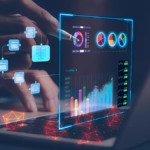
How to Unlock the Value of Your Data with a Modern Data Platform
2 January 2024
Unlocking the Power of Snowpro – Your Gateway to Success
4 January 2024
Published by
BluePi
Data-Driven Business Transformation
Mastering the Art of Demand Forecasting – A Comprehensive Guide
The Essence of Demand Forecasting
Demand forecasting is the art of foreseeing the demand for a product or service in the future. It’s not a mystical crystal ball but a systematic approach grounded in historical data, market analysis, and a diverse array of methods. The insights gleaned from demand forecasting are invaluable for several compelling reasons:
- Efficient Inventory Management: Demand forecasting empowers businesses to maintain optimal inventory levels. Stocking too much ties up capital, while understocking results in missed sales opportunities. Striking the right balance is essential for profitability.
- Streamlined Production Planning: Manufacturers rely on demand forecasts to plan their production schedules meticulously. This ensures they produce enough to meet customer demand without falling into the pitfalls of overproduction.
- Resource Allocation: Effective demand forecasting aids in allocating resources efficiently, from human capital to raw materials. This resource optimization translates to cost savings.
- Strategic Budgeting: : Accurate forecasts play a pivotal role in budgeting and financial planning. They ensure that funds are allocated judiciously, aligning with anticipated demand.
- Market Expansion: : For businesses eyeing expansion into new markets, demand forecasts provide crucial insights into the potential success of such ventures. It’s a strategic compass for expansion decisions.
The Art and Science of Demand Forecasting
Demand forecasting methods can be broadly categorized into two camps: qualitative and quantitative approaches. Each has its unique strengths and is deployed in specific scenarios.
Qualitative Methods
Qualitative methods rely on expert judgment, market research, and subjective opinions. They shine in situations where historical data is scant or when dealing with groundbreaking products. Here are some notable qualitative methods:
- Market Research: This method involves gathering data from potential customers through surveys, focus groups, and interviews. It offers a window into customer preferences, purchasing behavior, and emerging market trends.
- Delphi Method: In the Delphi method, industry experts anonymously provide their forecasts. These forecasts undergo multiple rounds of feedback and refinement until a consensus is reached. It’s a collaborative approach to forecasting.
- Expert Opinion: Experienced professionals within the organization or industry offer their judgment on future demand based on their knowledge and expertise. This method leverages the wisdom of seasoned veterans.
Quantitative Methods
Quantitative methods, on the other hand, rely on historical data and statistical techniques to make forecasts. They shine when historical data is abundant and patterns are discernible. Here are some prominent quantitative methods:
- Time Series Analysis: Time series analysis involves dissecting historical data points to identify patterns and trends. Techniques like moving averages and exponential smoothing are applied to make forecasts. It’s akin to reading the rhythms of data.
- Regression Analysis: Regression analysis delves into the relationship between product demand and various factors like price, advertising expenditure, and economic indicators. It quantifies the impact of these factors on demand.
- Machine Learning: The advent of machine learning and artificial intelligence has revolutionized demand forecasting. Advanced algorithms dissect vast datasets, uncovering intricate patterns. These models evolve and improve with more data, making them incredibly powerful tools.
- Causal Models: Causal models consider cause-and-effect relationships. For example, if an increase in advertising spending historically led to higher demand, a causal model would incorporate this relationship into the forecast. It’s about understanding the domino effect of factors.
- Simulation: Simulation models create artificial scenarios to predict demand. They are particularly useful for testing the impact of various factors on demand, such as changes in pricing or marketing strategies. It’s a virtual crystal ball.
Choosing the Right Methodology
Selecting the right demand forecasting method is akin to selecting the right tool for a specific task. It hinges on several crucial factors:
- Data Availability: Consider the availability and quality of historical data. Quantitative methods thrive when robust data is present, while qualitative methods offer flexibility in data-scarce scenarios
- Forecasting Horizon: The time frame for the forecast plays a significant role in methodology selection. Short-term forecasts may lean more towards quantitative methods, while long-term forecasts might blend expert opinions and market research.
- Product Characteristics: The nature of the product or service being forecasted also influences the choice of methodology. Innovative or highly seasonal products might benefit from a fusion of qualitative and quantitative approaches.
- Start Small: Don’t feel overwhelmed. Start small and gradually expand your usage of Snowpro. This way, you can ease into the platform and fully grasp its capabilities.
The Future of Demand Forecasting
Demand forecasting is far from a static field. It evolves in tandem with technological advancements, data accessibility, and shifts in consumer behavior. Here’s a glimpse into the future of demand forecasting:
- Big Data and AI Integration: The integration of big data and AI will continue to elevate the accuracy of demand forecasts. Machine learning algorithms will unearth intricate patterns within colossal datasets, offering more precise predictions.
- Real-time Forecasting: As businesses operate in increasingly real-time environments, demand forecasting will also shift towards real-time accuracy. Instantaneous data updates will drive on-the-fly adjustments, ensuring businesses stay agile.
- Predictive Analytics Dominance: Predictive analytics, powered by AI, will not only forecast demand but also provide actionable insights. It will enable businesses to proactively respond to changing market dynamics, gaining a competitive edge.
- Collaborative Forecasting: Collaborative forecasting will involve various stakeholders, including suppliers and customers, in the forecasting process. This inclusivity will lead to more accurate forecasts and better alignment of supply chains, reducing inefficiencies.
Conclusion
Demand forecasting is the compass that steers businesses through the turbulent seas of market dynamics. It’s a blend of science and art, combining historical data, statistical wizardry, and expert judgment. As technology continues to advance, and businesses generate ever-increasing volumes of data, the accuracy and timeliness of demand forecasts will inevitably improve. Choosing the right Demand Forecasting Method is akin to selecting the right path through a dense forest. It depends on various factors, including data availability, forecasting horizon, and the nature of the product or service. The future of demand forecasting is a thrilling landscape, with AI, big data, and predictive analytics leading the way. Whether you’re a seasoned business leader making strategic decisions or a data analyst meticulously crunching numbers, understanding demand forecasting methods is paramount in today’s fiercely competitive landscape. It’s not just about predicting the future; it’s about actively shaping it. So, master the art of demand forecasting, and let it be your guiding star in the world of business.
About the Author

Published by
BluePi
Data-Driven Business Transformation

Published by
Sidhant Arora
Marketing Manager
With 8+ years of brand and marketing expertise, Sidhant has empowered 50+ businesses across industries. His passion lies in crafting impactful 360° strategies that seamlessly blend storytelling and targeted campaigns, guided by data-driven insights. He sculpts compelling narratives that resonate with target audience crafting focused campaigns to expand brand presence across digital, offline, and PR channels to unlock their full potential.































